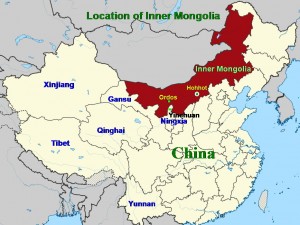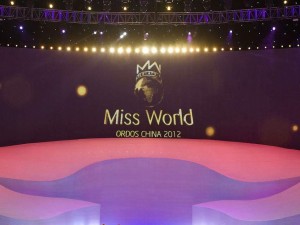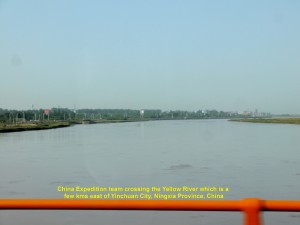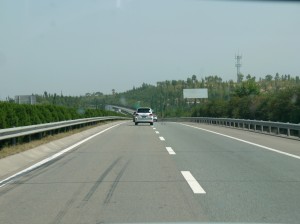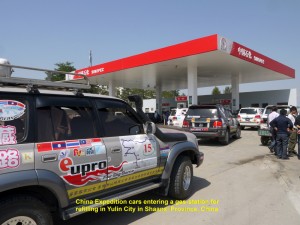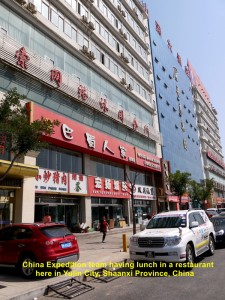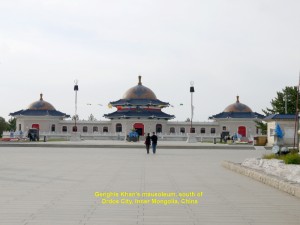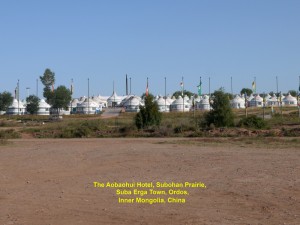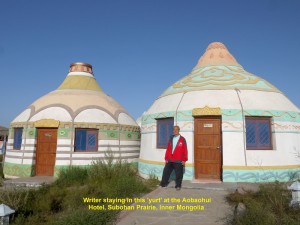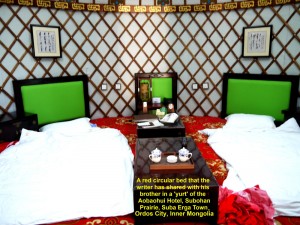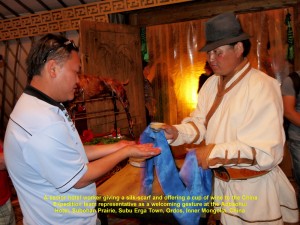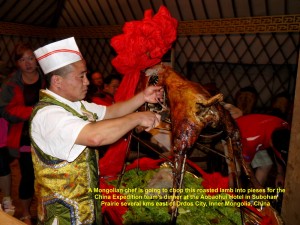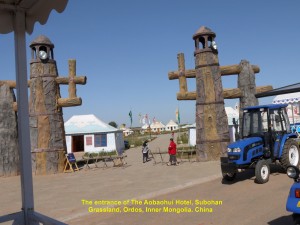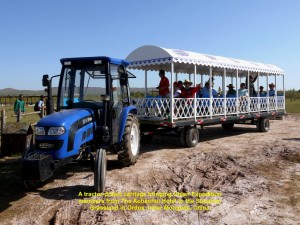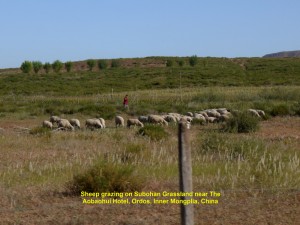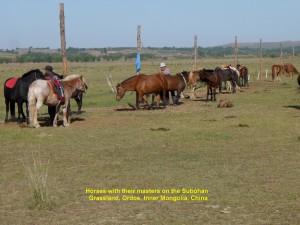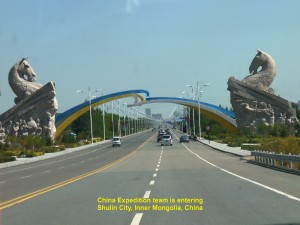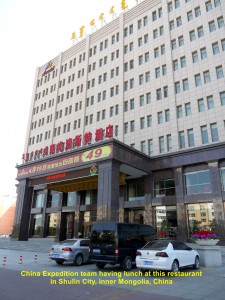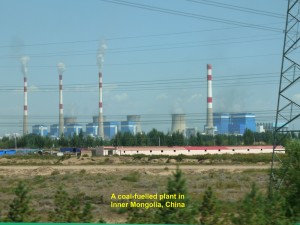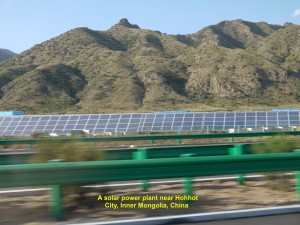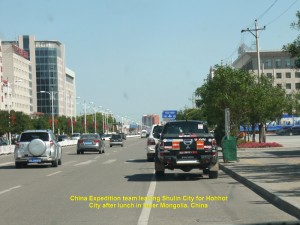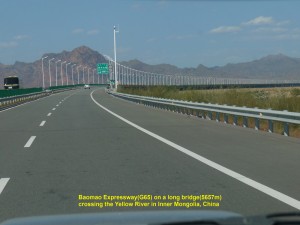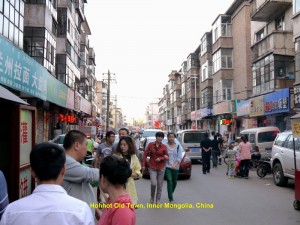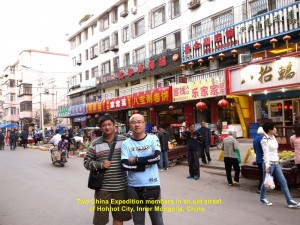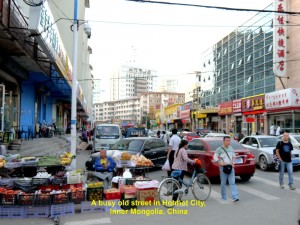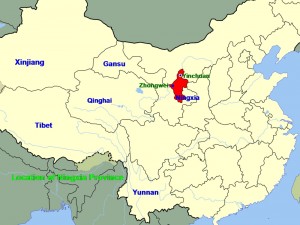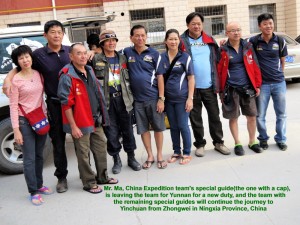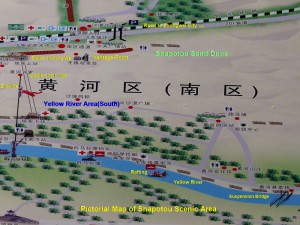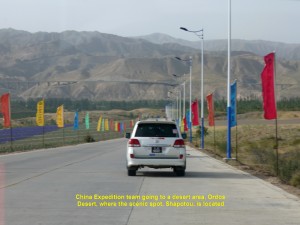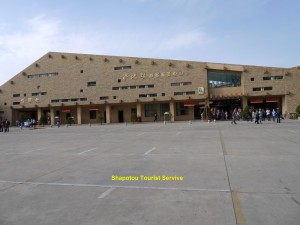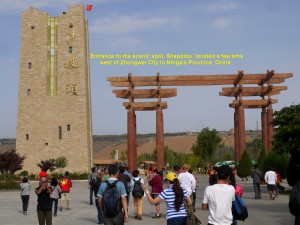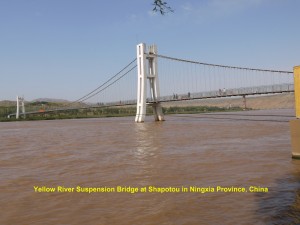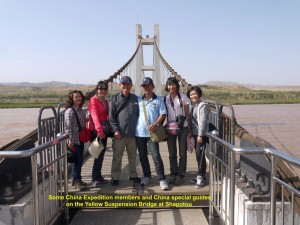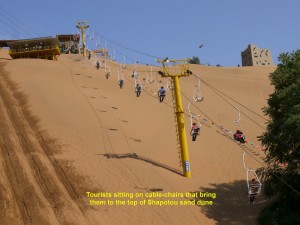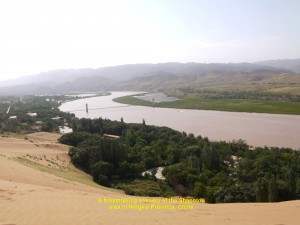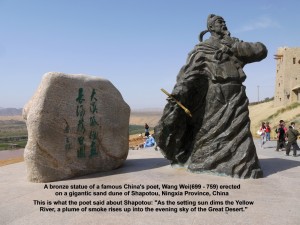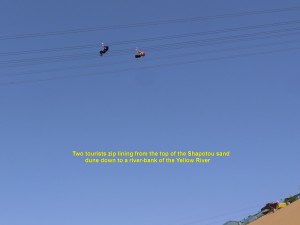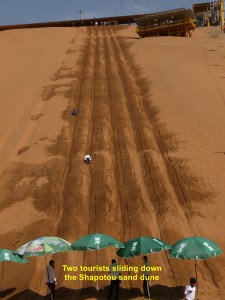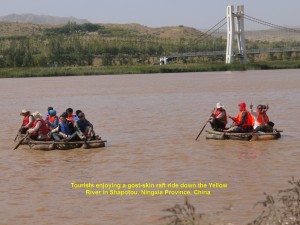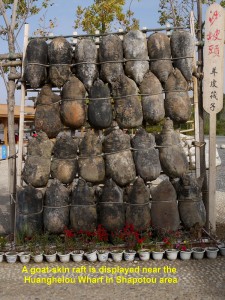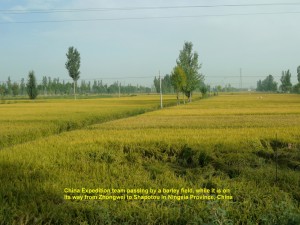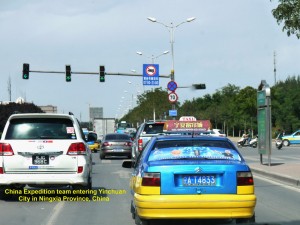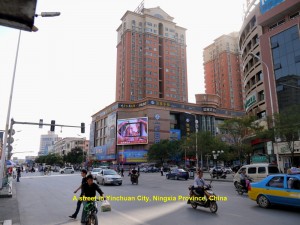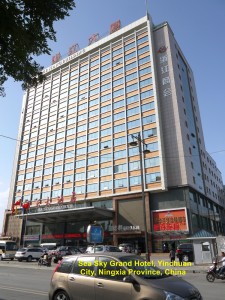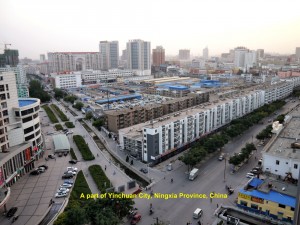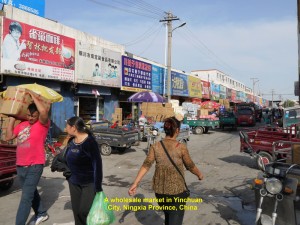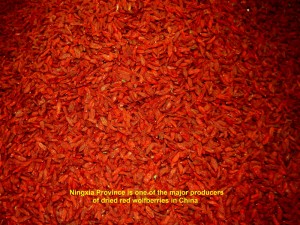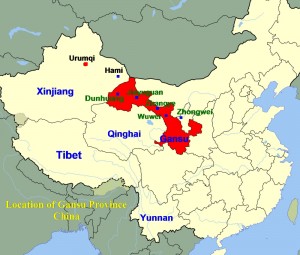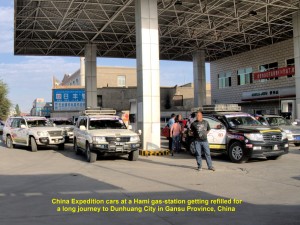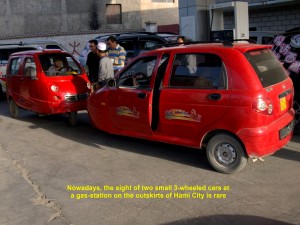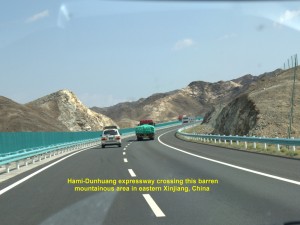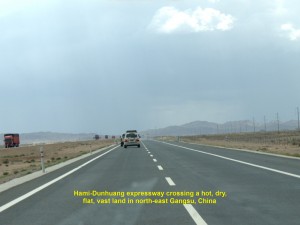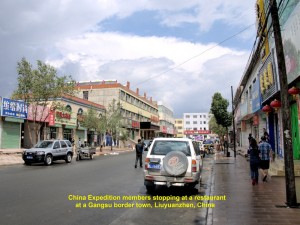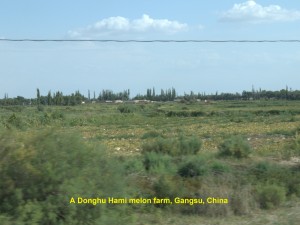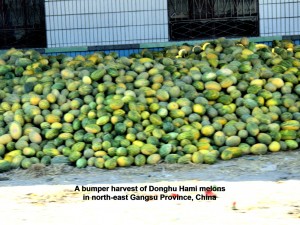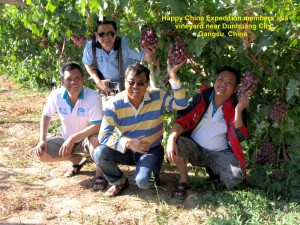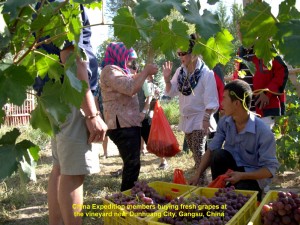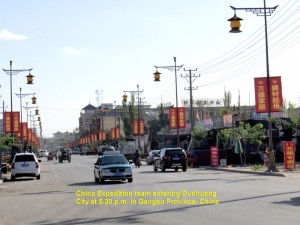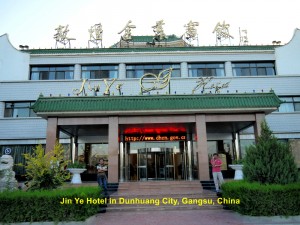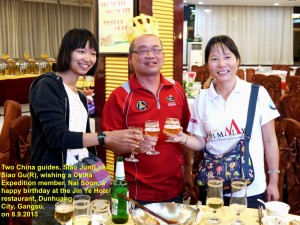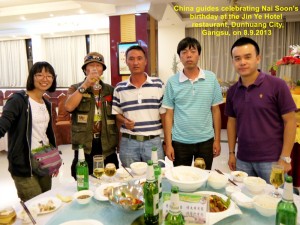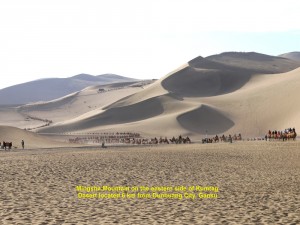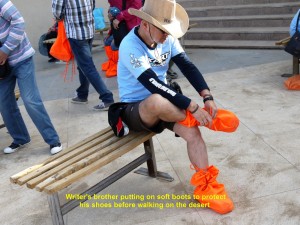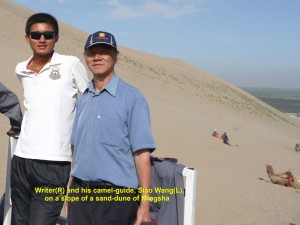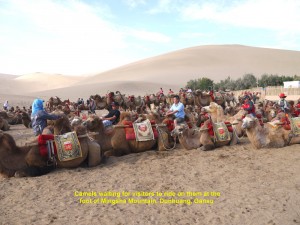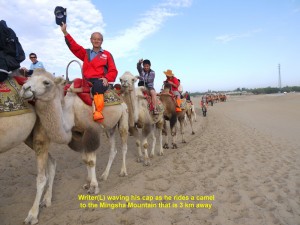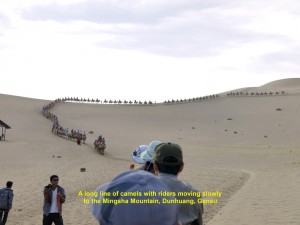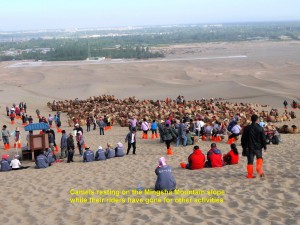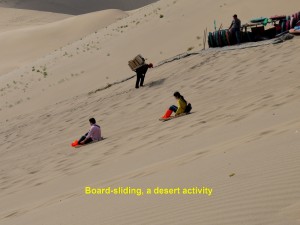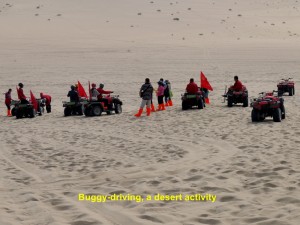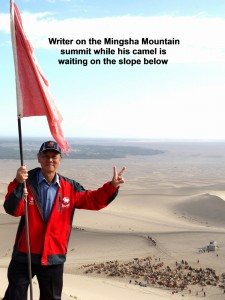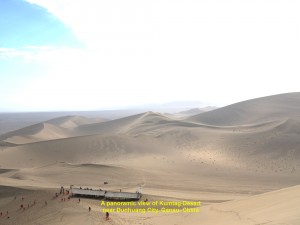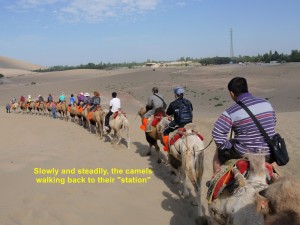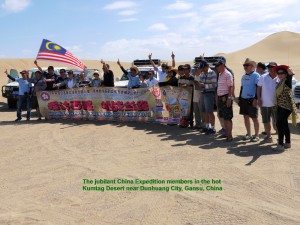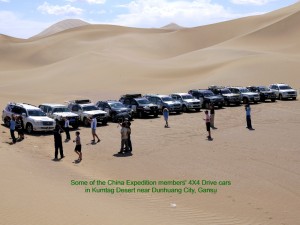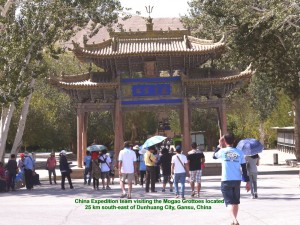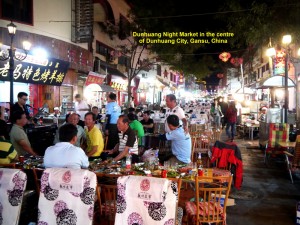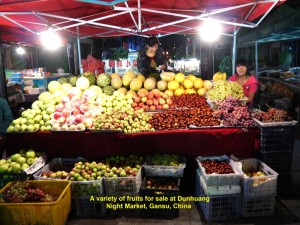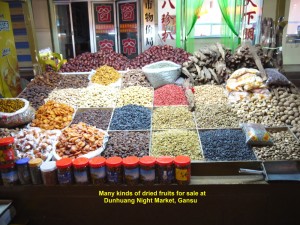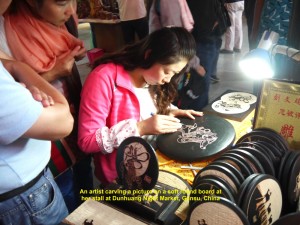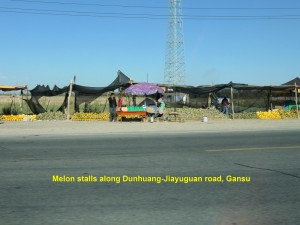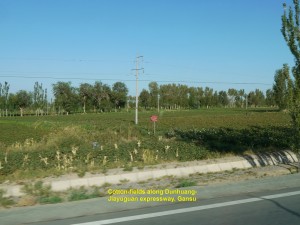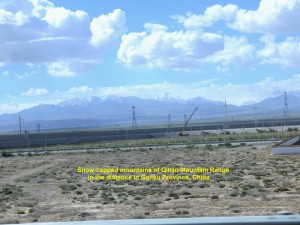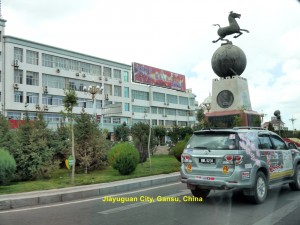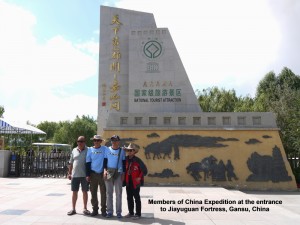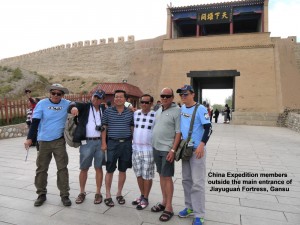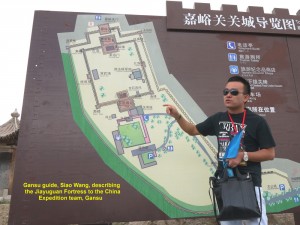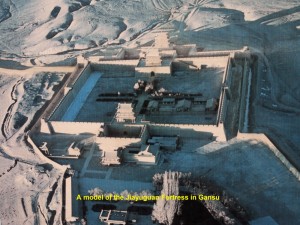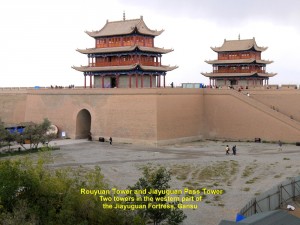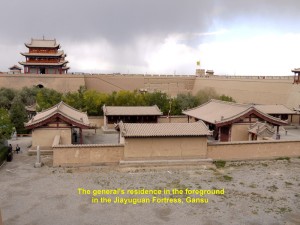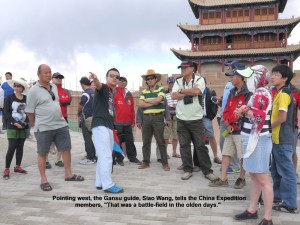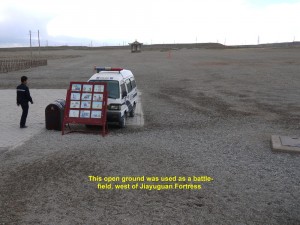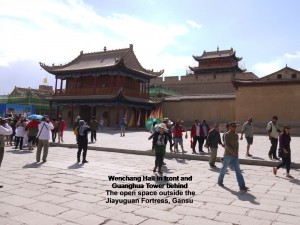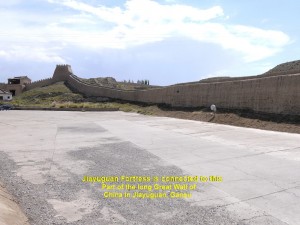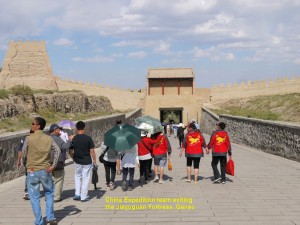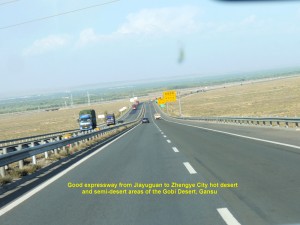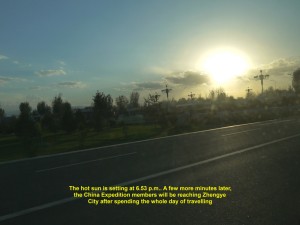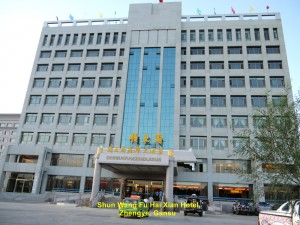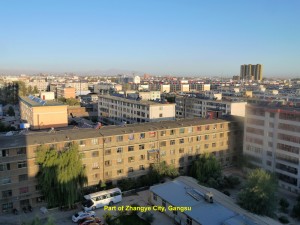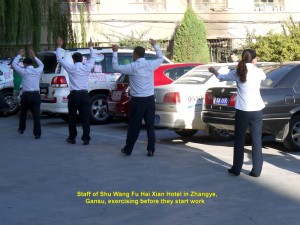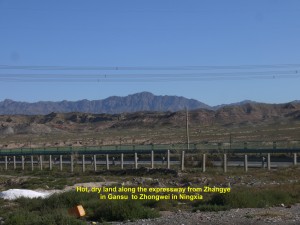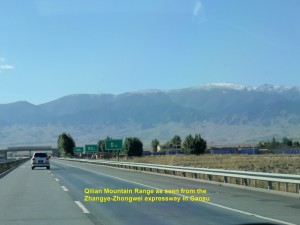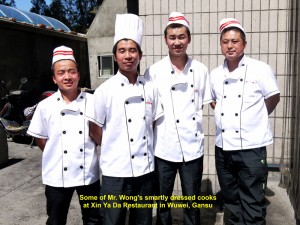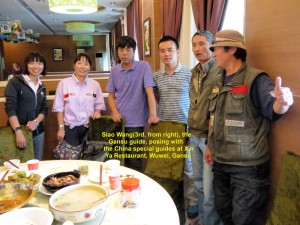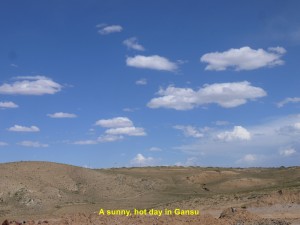Journal of my 2013 China Expedition Part VIII (Inner Mongolia)
Journal of My 2013 China Expedition Part VIII (Inner Mongolia)
Inner Mongolia Journey
Day 30 (Friday, 13.9.2013)
Yinchuan – Ordos
(Distance: 458 km)
At 8.20 a.m., we left Yinchuan City in Ningxia Province for Ordos City which is 458 km away in Inner Mongolia. Ordos City became well-known all over the world when it held the Miss World Pageant in 2012, and Miss China PR, Yu Wenxia, won the crown after beating 115 contestants.
While travelling east from the city we crossed the Yellow River. Later, we passed through farmlands, grasslands and lowlands where tall trees were growing.
After five hours of travelling on a good expressway, G65 Baomao Expressway. we reached Yulin City at the northern border of Shaanxi Province where we stopped at a restaurant for lunch. After lunch we headed north for Ordos City. At 4 p.m. we reached the Genghis Khan’s Mausoleum Tourist District located near Ejin Horo Qi Town and several kms south of Ordos City.
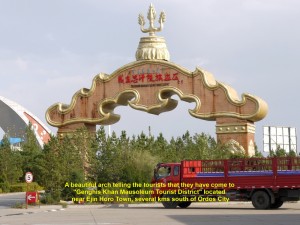
An arch over a road to the Genghis Khan’s Mausoleum Tourist District, near Ejin Horo Town, Ordos, Inner Mongolia, China
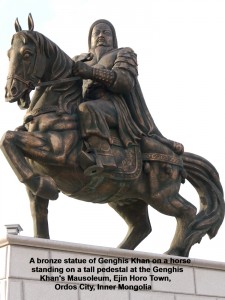
A bronze statue of Genghis Khan on a horse on a high pedestal at Genghis Khan’s Mausoleum, Ejin Horo Town, Ordos City, Inner Mongolia
Genghis Khan(1162-1227) ruled Mongol Empire or Yuan Dynasty(1271-1368) that covered China and a large part of Central Asia from 1206 until he passed away in 1227. Nobody knows the cause of his death nor the location of his tomb in Mongolia. His successors extended his empire to the west as far as eastern Europe, south Russia and the Middle-East.
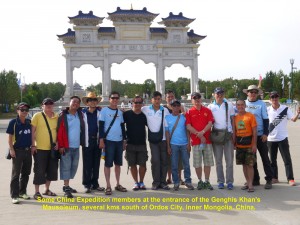
China Expedition members visiting Genghis Khan’s Mausoleum, near Ejin Horo Town, Ordos City, Inner Mongolia, China
In this tourist area there is a unique building which looks like a grand palace painted in white, blue and orange. It consists of three octagonal halls in a shape of a typical Mongolian home known as yurt. They are connected to each other by covered corridors. Along these corridors are frescos depicting the life of Genghis Khan and the great achievements of his grandson, Kublai Khan.
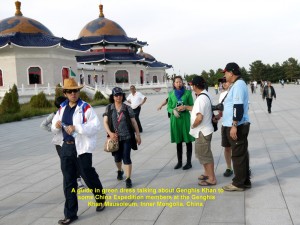
A guide in green dress talking about Genghis Khan to some China Expedition members at the Mausoleum, Ejin Horo Town, Ordos City
Construction of this grand building started in 1954 and completed in 1956 with the purpose of making it a place for Genghis Khan’s mausoleum. The Mongolians consider it a temple where they worship Genghis Khan as their god. They gather at this mausoleum in large numbers four times a year to worship Genghis Khan, and hold competitions such as horse-riding, wrestling, singing and archery after the worship-ceremonies.
The middle hall(Memorial Hall) which is the largest houses a large marble statue of Genghis Khan. Behind the statue is a large map showing Genghis Khan’s empire of the Yuan Dynasty(1271-1368) including lands in China, Central Asia and south Russia. A large room behind this hall houses empty coffins purported for Genghis Khan, his three wives and two brothers.
One of the two smaller halls houses Genghis Khan’s relics and the other two empty coffins, one purported for one of his wives and the other his fourth son.
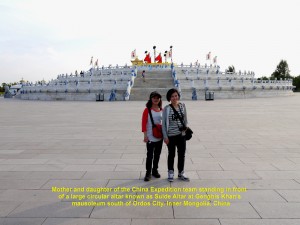
Sulde Altar, a large 3-levelled, circular structure, where Mongolians worship Genghis Khan, sky, heaven, etc. at the Genghis Khan’s Mausoleum, Inner Mongolia
There is a large, three-levelled circular structure of 54 metres in diameter known as Sulde Altar which is a short distance from this grand building. Sulde Altar is a consecrated place for Mongolians to worship Genghis Khan and heaven.
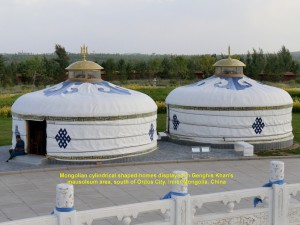
Two white yurts near Sulde Altar at Genghis Khan;s Mausoleum are shown as Mongolian houses, at the Mausoleum
Near this worshipping place are two white yurts(Mongolian houses) that are set up as an exhibit for tourists to see. Further away from the mausoleum is a sacred place on a high ground. A row of small cone-shaped structures of stones leads to the largest one. Mongolians come here on the 21st. of March of their lunar calendar every year to worship Genghis Khan, his horse, mountains, rivers, spirits, stars and heavens.
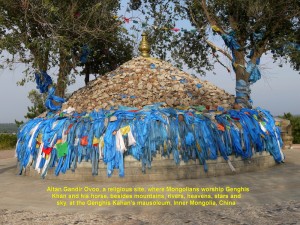
Altan Gandir Ovoo, a religious site where Mongolians worship Genghis Khan at the Mausoleum, Ejin Horo Town, Ordos City, Inner Mongolia
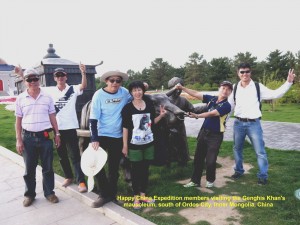
China Expedition members at the Genghis Khan’s Mausoleum, Ejin Horo Town, Ordos City, Inner Mongolia, China
Before we left the Mausoleum at 6 p.m., we had a group photograph at its entrance for remembrance. Then we moved on again. This time we were going to Suba Erga Town which was several kms north-east of Ordos City.
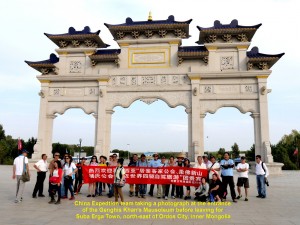
China Expedition team taking a photo at the entrance of Genghis Khan’s Mausoleum, Ejin Horo Town, Ordos City, Inner Mongolia
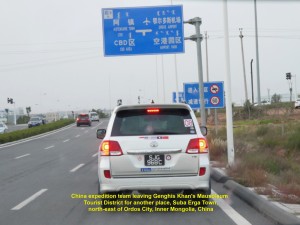
China Expedition team leaving Genghis Khan’s Mausoleum Tourist District for Suba Erga Town, north-east of Ordos City, Inner Mongolia
Over an hour later, we reached the town and then went to a hotel on a prairie(grassland), Subohan Prairie, nearby. Known as the Aobaohui Hotel, it was a unique hotel consisting of over a hundred Mongolian-styled houses known as ‘yurts’. Each ‘yurt’ has a large circular bed for two or three guests, a modern bathroom and a television set.
On arrival at the hotel, we went to a large tent for dinner. Before the dinner began, a short welcoming ceremony was held. One of our members acting as our representative received a cup of wine and a silk-scarf from a senior hotel officer as a gesture of hospitality. Then we had a sumptuous dinner that included a delicious dish of roasted lamb. After dinner, we retired in the ‘yurts’.
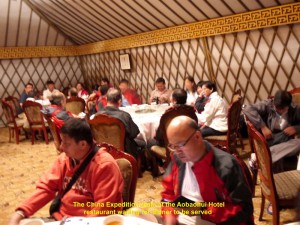
China Expedition team waiting for dinner at the Aobaohui Hotel, Subohan Prairie, Suba Erga Town, Ordos City, Inner Mongolia
Day 31(Saturday, 14.9.2013)
Ordos – Hohhot
(Distance: 316 km)
After breakfast, we gathered at the entrance of The Aobaohui Hotel waiting for a tractor-drawn carriage to bring us to a grassland behind the hotel. At 9.30 a.m. it came and brought us to a spot on the grassland for a horse-ride.
As we were going to the place, we saw sheep grazing in the distance and cows crossing our path. After a 20-minute bumpy ride on a dirt road, we reached the spot on the vast Subohan Grassland where we saw a few ‘yurts’ and several horses with their masters.

Some Expedition members on Subohan Grassland getting ready for a horse-ride, Ordos, Inner Mongolia, China
Then some of us took a horse-ride which cost us RMB 200 each. As it was going to be my first experience of riding a horse, I felt a little bit worried that I might be thrown off a horse’s back. But when I watched my friends riding their horses, comfortably, my fear disappeared. The ride was a short one but I did enjoy it. That was my unforgettable experience.
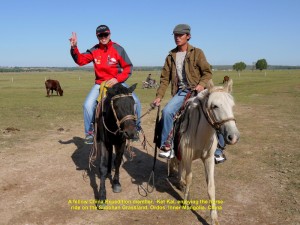
A fellow-member, Ket Kai, enjoying the horse-ride on Subohan Grassland, Ordos, Inner Mongolia, China
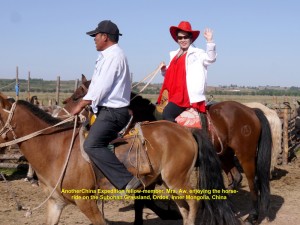
Another fellow-member, Mrs. Aw, enjoying a horse-ride on Subohan Grassland, Ordos, Inner Mongolia, China
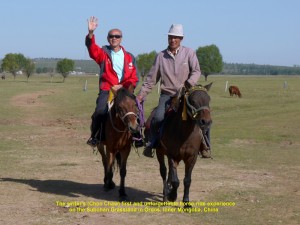
The writer, Choo Chaw, enjoying his first, unforgettable horse-ride on Subohan Grassland, Ordos, Inner Mongolia, China
Later, we all left the hotel at 10.30 a.m. and travelled over 300 km to a city in the east, Hohhot, which is the capital of Inner Mongolia. The sky was clear, but the weather was hot in this semi-desert area of Inner Mongolia.
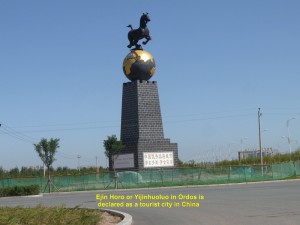
Tall structure with a statue of a horse on a globe at a roundabout in Ordos declaring Ordos as a tourist city in China
While travelling on a good expressway, G6 Jingzang Expressway, to Hohhot, we saw some coal-fired power plants and solar-energy power plants too. Inner Mongolia is one of the top three major consumers of coal. The emission of acidic gases and soot from the coal-fired plants has caused a serious impact on the environments and people’s health. The solar and wind energies are renewable sources and do not cause pollution. China is continuing developing these sources and hoping that carbon emission will soon be reduced, greatly.
At 1.30 p.m. we stopped in Shulin City to have lunch at a restaurant. Then at 2.30 p.m. our journey resumed. On the way, we crossed a Yellow River plain and 5657 metre-long bridge over the Yellow River. On the fertile plain, crops, like barley, corns and wheat, were grown.
Finally, at 5.00 p.m. we entered Hohhot City, the capital of Inner Mongolia, and checked in at Hailiang Plaza Hotel. After leaving our luggage in our rooms, we visited a few streets of the old part of the city.
At 6.30 p.m. we felt hungry and entered a small restaurant. We ordered a few dishes and sat down to eat. Later, the lady-owner of the restaurant brought a few more dishes for us. Then she told us that the whole meal was on the house as she was happy to see Malaysians enjoying her food. We were, pleasantly, surprised and thanked her. In return, I took out a RM 10 Malaysian currency and gave it to her as a souvenir. After taking a few photos with her and her husband, we thanked and bade them farewell, and continued our sightseeing of the old part of the city.
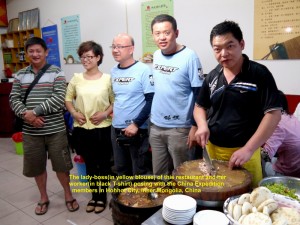
China Expedition members taking a photo with the lady-boss(in yellow blouse) and worker(in black T-shirt) in her restaurant, Hohhot City, Inner Mongolia, China
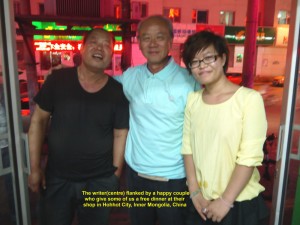
Writer(middle) taking a photo with the happy couple, the owners of a restaurant in Hohhot City, Inner Mongolia, China
Journal of My 2013 China Expedition:
Written by Choo Chaw, Kluang, Johor, Malaysia
Journal of My 2013 China Expedition Part VII (Ningxia)
Journal of My 2013 China Expedition Part VII (Ningxia)
Ningxia Province Journey
Day 29(Thursday, 12.9.2013)
Zhongwei – Yinchuan
Distance: 201 km
Before we began our journey from Zhongwei to Yinchuan, we bade farewell to Mr. Ma, one of our China’s special guides, who had helped us in our expedition for the past several days. He had to go back to Yunnan to take up a new duty.
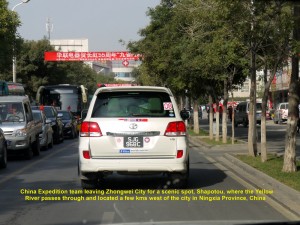
The China Expedition team leaving Zhongwei City for a Shapotou scenic spot located a few kms west of the city
At 9 a.m. we left Zhongwei City and headed westwards to a famous scenic spot known as Shapotou. Located a few kilometres from the city, Shapotou is a gigantic sand dune in the south-east of the Tengger Desert. It is 2000 m wide, 100 m high and inclines at an angle of 60 degrees. It slopes down to the S-shaped part of the Yellow River.
On arrival at the place, we bought tickets and entered the scenic area. As we were walking along the Yellow River, we saw a long suspended bridge for pedestrians spanning the river.
After walking for a few hundred metres, we reached a cable-chair station. Then we sat on cable-chairs and went to the top of the Shapotou’s large sand dune. When we reached the top, we walked to a vantage-spot where we were amazed to see an awesome panoramic view of the large sand dune sloping steeply down over 100 metres to a bend of the Yellow River, the curved river, trees and hills in the distance.
Erected at the viewing spot was a large bronze statue of a famous China’s poet during the Tang Dynasty. He was also a painter, musician and statesman. Wang Wei(699 – 759) was his name. He wrote what he saw one evening in the scenic Shapotou area:”As the setting sun dims the Yellow River, a plume of smoke rises up into the evening sky of the Great Desert.”
Walking back to the cable-chair terminal, we had three choices of going down to the bottom of the sand dune: cable-car ride again, zip-lining or sand-sliding. For me, I chose to go down by cable-chair ride as I wanted to record on my camera the breathtaking view of the Yellow River and its surrounding.
While we were walking back to the Shapotou entrance, we saw some of our fellow-members on rafts floating down the Yellow River. They had come down the sand dune by zip-lining and then went down the river by the rafts. Those rafts were unusual ones. Each one was made of a square wooden platform with over 25 air-filled goat skins tied to its underside, and could carry about 8 persons.
At 11.30 a.m. we left the Shapotou scenic area and travelled east to Yinchuan City which was about 200 kms away. We were travelling on a good expressway that crossed hot, arid land. Occasionally, we passed farmlands of barley, corns and wolfberries that were irrigated by water from oases and rivers.
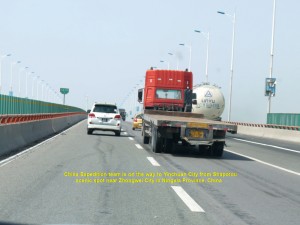
China Expedition team leaving the Shapotou scenic area near Zhongwei City for Yinchuan City in Ningxia Province, China
Three hours later, we, finally, reached Yinchuan City where we checked in at Sea Sky Grand Hotel. The Yinchuan City is the capital of Ningxia Province and has a population of about 2 millions.
Having checked in at the hotel, some of us were craving for western food which we had missed for many days. As we were walking down a road for a short while from the hotel, we were glad to find a KFC fried chicken outlet. We entered the eatery, ordered the food and ate with glee.
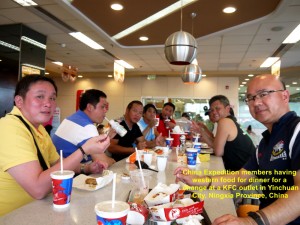
Some China Expedition members enjoying western food at a KFC outlet in Yinchuan City, Ningxia Province, China
Later, Cho Tat, my brother, and I strolled in the neighbourhood of the hotel. We came across a market where wholesale trade of many kinds of goods was carried out, actively. We stopped at a shop where we bought several kilograms of dried red wolfberries for our loved ones and friends back home in Malaysia. These dried fruits which are small are usually used in Chinese tonic soups. Ningxia Province is one of the major producers of these fruits in China.
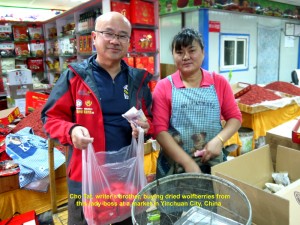
Writer’s brother(L), Cho Tat, buying dried red wolfberries at a wholesale market in Yinchuan City, Ningxia Province, China
Journal of My 2013 China Expedition:
Written by Choo Chaw, Kluang, Johor, Malaysia
Journal of My 2013 China Expedition Part VI (Gansu)
Journal of My 2013 China Expedition Part VI (Gansu)
Gansu Journey
Day 25 (Sunday, 8.9.2013)
Hami to Dunhuang
(Distance: 404 km)
At 9 in the morning we all left Jiageda Hotel in Hami City and went to a gas-station on its outskirts to refill our vehicles. Standing at the station we looked at the city in the distance for the last time, as were going to another city, Dunhuang in Gansu Province, about 404 km away. Then we were surprised to see two red small cars that had three wheels each came appeared at the gas-station. That was my first time seeing such a kind of vehicles.
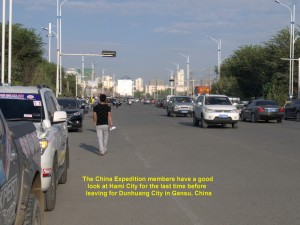
China Expedition members looking at Hami City for the last time before moving on to Dunhuang City in Gansu Province, China
Soon we were on our journey to Dunhuang City. At the beginning, we were crossing hot, dry, vast, flat land, barren mountainous areas, and then flat land again.
At 1.30 p.m. we stopped at a small restaurant for lunch at a small town, Liuyanzhen. An hour later, we were off again. Later, we were travelling across a fertile land where Donghu Hami melons and watermelons were grown, and then more fertile lands where cotton plants and grapevines were grown.
At 5 p.m., we stopped at a vineyard near Dunhuang City. Fortunately, the owner and his family were busy harvesting their large, juicy purple grapes. With the owner’s permission, we entered his vineyard. The moment we stepped in, we all felt delighted to see so many bunches of ripe grapes hanging from the vines. We were lucky to have come at the right time when the fruits ripened. Happily, all of us took several shots with the fruits. Before we left, many of us bought some of his grapes and ate them with joy.
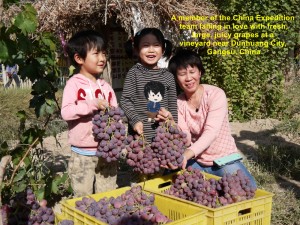
A China Expedition member has fallen in love with the large, juicy grapes at a vineyard near Dunhuang City, Gansu, China
At 5.30 p.m. we, finally, reached Dunhuang City and checked in at a hotel, Jin Ye Hotel.
At 7.30 in the evening, we had dinner at the hotel. While having dinner, we celebrated one of our member’s birthday, Tang Nai Soon. He was so happy that we all felt delighted. It should be a memorable celebration for him.
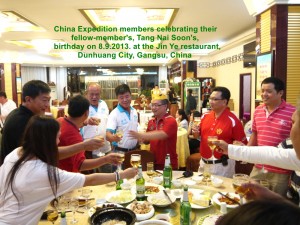
China Expedition members celebrating their fellow-member’s birthday on 8.9.2013 in Dunhuang City, Gansu
Day 26 (Monday, 9.9.2013)
Dunhuang in Gansu Province
At 8.20 in the morning we left Jin Ye Hotel and went to Mingsha Mountains which were actually high sand dunes in Kumtag Desert located 6 km south of Dunhuang City.
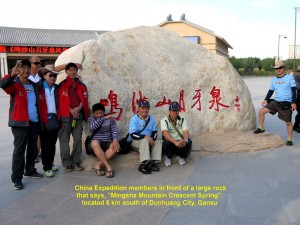
China Expedition members in front of a large rock that says “Mingsha Mountain Crescent Spring” located 6 km south of Dunhuang City, Gansu
On arrival we were amazed to see so many tourists going for camel ride. We bought tickets to ride the camels too. Before riding on them, we put on bright orange soft boots to protect our shoes.
Soon we were riding on the camels. I was in a group of six tourists each of us riding a camel. The camels were tied to each other with a rope and led by a camel-guide, Siao Wang, in front. Soon we were joining a long line of camels with riders that snaked its way in the direction of a high dune that was three km away.
Half an hour later, we reached a higher elevation on a sand-dune where we all alighted from the camels and were asked to go for other activities, e.g. board-sliding and buggy-driving, for a short while.
I climbed up to the summit of the Mingsha Mountain(a high sand-dune) and saw a panoramic view of the desert area which was breathtaking. Later, I sat on a circular tube and went down a steep slope of the dune for a short distance. That was an enjoyable activity which I had not done so for many years. The last time I slid down a slope was when I was on a snow-covered slope of Titlis Mountain in Switzerland in 2004.
Having spent over half an hour on the large sand-dune, Mingsha Mountain, we mounted the camels again and our camel-guide led the camels down the dune, slowly. That was my first, enjoyable and unforgettable experience.
At 12 noon we had lunch. After lunch we went to a spot in Kumtag Desert which was several kilometres from Dunhuang City. At that spot some of our car-owners showed off their skill at driving on sand dunes without getting their vehicles stuck in the sand. There were a few unlucky ones whose cars got stuck and had to be pulled out of the sand by other vehicles. We, the spectators, were enjoying our fellow-members’ brave desert actions.
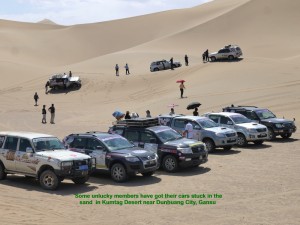
Two unlucky cars in the distance got stuck in the sand in the Kumtag Desert near Dunhuang City, Gansu
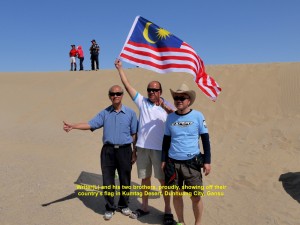
Writer(L) and his two brothers, proudly, showing off their country’s flag in the Kumtag Desert near Dunhuang City, Gansu
Later, we went to an ancient place that was 25 km south-east of Dunhuang City. Known as Mogao Grottoes, it has over 700 holes or “caves” dug out in the cliff of a hill between the 4th. and 14th. Century when the north silk route was the only overland road linking China in the east with regions in the west.
In the ancient times, there were many Buddhist scrolls, manuscripts, scriptures, statues, sculptures and murals in the “caves”. But now tourists could see repainted Buddhist murals and restored statues only in some of the”caves”. It was believed that treasure hunters had taken away many of those things in the last 100 years.
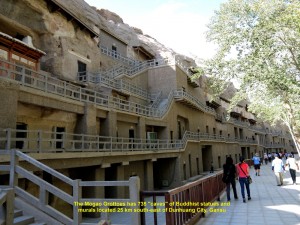
The Mogao Grottoes consisting of 735 “caves” containing Buddhist statues and murals near Dunhuang City, Gansu
When we arrived at the Mogao Grottoes, Miss Low, a guide, welcomed and brought us round to see some of the “caves”. There were four storeys of “caves” which were accessible by stair-cases. Miss Low brought us to the first two storeys and entered a few “caves” to see the murals and old Buddhist statues that were restored. We noticed that there were many “caves” in ruin and under lock. We spent about an hour and a half at that place before we left for our hotel in Dunhuang City.
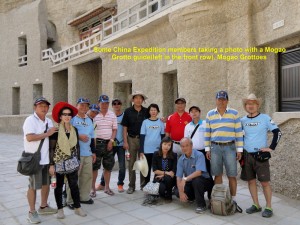
China Expedition members and a guide, Miss Low(squatting beside the writer), at the Mogao Grottoes, Dunhuang, Gansu
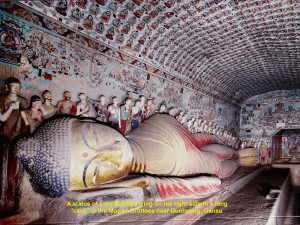
A statue of Lord Buddha lying on his right side in a long “cave” in the Mogao Grottoes, Dunhuang, Gansu
In the evening, we went to Dunhuang Night Market in the city-centre to have dinner at a eatery belonging to Uncle Salleh. Uncle Salleh, a friendly and happy Xinjiang man, had prepared a sumptuous dinner for us, members of the China Expedition. He served us grilled lamb and chickens, and a few kinds of salads. We thanked him for such good food that we had missed for the last over twenty days during our expedition.
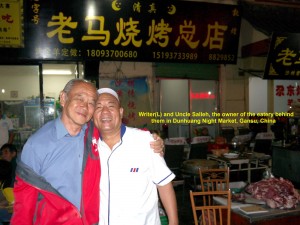
Writer(L) and Uncle Salleh, the proud owner of the eatery behind him at the Dunhuang Night Market, Gansu
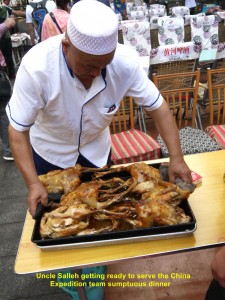
Uncle Salleh getting ready to serve the China Expedition members dinner at his eatery at Dunhuang Night Market, Gansu
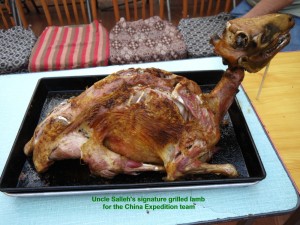
Uncle Salleh’s signature grilled lamb for the China Expedition members’ dinner at Dunhuang Night Market, Gansu
As we were enjoying the dinner we were entertained by a young local couple singing several popular Chinese songs. A few fellow-members, happily, joined in the singing.
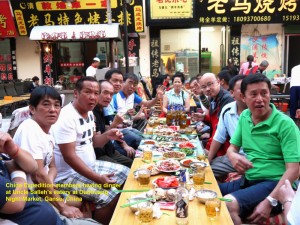
China Expedition members enjoying a sumptuous dinner at Uncle Salleh’s eatery at Dunhuang Night Market, Gansu
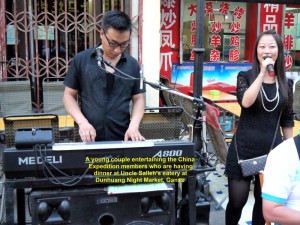
A young couple entertaining the China Expedition members who are having dinner at Dunhuang Night Market, Gansu
Before I went back to our hotel, I took a stroll to see many stalls selling handicrafts, clothes, foot-wear, fresh and dried fruits, etc. at the Dunhuang Night Market.
Day 27 (Tuesday, 10.9.2013)
Dunhuang – Zhengye
(Distance: 596 km)
At 8.45 a.m. we left Dunhuang City and travelled east to Zhengye City, a distance of 596 km away. On the way we came across cotton-fields and farms of sunflowers, barley and melons. But quite often we crossed hot, vast land in the Gobi Desert which was either semi-desert or desert with barren hills in the distance. After two hours of travelling, we saw a long mountain range, Qilian Mountain Range, with snow-capped mountains in the distance.
At 12.30 p.m. we arrived at Jiayuguan City where we met a young handsome Gansu guide, Siao Wang, and had lunch at a restaurant. Then we went to an ancient fortress which was 6 km away. It was known as Jiayuguan Fortress which was also a pass through the western Great Wall of China.
Built in 1372 in the Ming Dynasty to fend off invasion from the west, Jiayuguan Fortress has a wall in a shape of trapezium connected to the Great Wall of China. Within this wall is another wall that is higher and thicker, but square in shape. To make the fortress safer a moat was built outside the first wall.
The inner fortress has a gate in front in the east with a tall tower on top known as Guanghua Gate, and two gates at the back in the west with tall towers on their top known as Rouyuan Gate and Jiayuguan Pass Gate. In the middle of this fort is the general’s residence. The back of the fortress faces a vast open ground which was a battle-field.
While we were walking on the walkway on the fortress wall, a strong sandstorm from the desert in the west came and went, suddenly. We had to covered our faces, quickly, as we had no time to look for a place to hide.
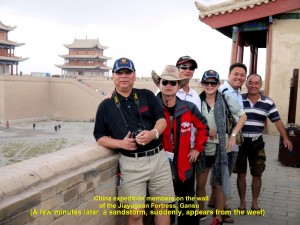
A sudden sandstorm occurs here while the China Expedition members are on the wall of the Jiayuguan Fortress, Gansu
After the interesting fortress tour, we walked back to our cars and continued our journey to Zhengye City at 4 p.m.. The expressway from Jiayuguan City to Zhengye City was good. It crossed hot desert and semi-desert areas of the Gobi Desert in Gansu. At 7 p.m. we finally arrived at Zhengye City where we had dinner and checked in at Shu Wang Fu Hai Xian Hotel in the centre of the city.
Day 28 (Wednesday, 11.9.2013)
Zhangye(Gansu) – Zhongwei(Ningxia)
(Distance: 570 km)
At 8 in the morning, some of our fellow-members, diligently, washed their cars clean in an open space near the hotel in Zhengye City. A few minutes later, a loud-speaker was playing a loud workout music and some hotel-workers appeared at the back of the hotel and began exercising. As I was watching them I felt I should join them in order to keep fit. Soon I was doing the workout with them for a short time. We had not done morning workout for quite sometime.
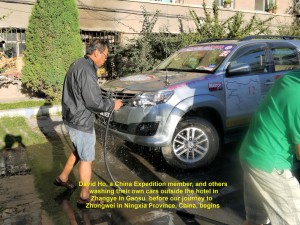
David Ho and other fellow-members of China Expedition, diligently, clean their own cars near the hotel in Zhangye City, Gansu
At 9 a.m. we left Zhangye City and travelled eastwards to Zhongwei City in another province, Ningxia, a distance of 570 km. It would be another long journey, and we always hoped that it would be another safe one like all the previous ones. The road to Zhongwei was good but lots of vehicles, small and large, were using it.
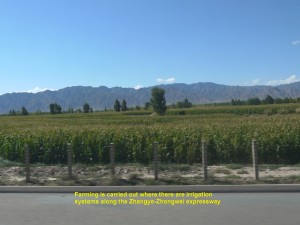
Farms are cultivated in areas where there are water irrigation systems along Zhangye-Zhongwei espressway, China
It crossed hot, dry lands and a few mountain ranges, e.g. Qilian Mountain Range, that could be seen in the distance from the road. Farms like barley, sunflowers, melons and corns were cultivated in some areas where water was available from irrigation systems or oases.
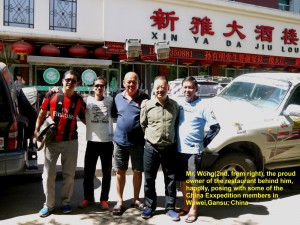
Mr. Wong(2nd. from right), the proud owner of the restaurant behind him, posing with some China Expedition members in Wuwei, China
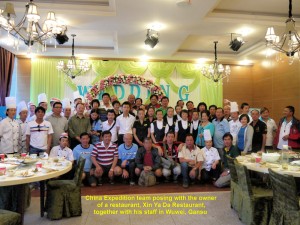
A group photo of Mr. Wong, his staff and members of the China Expedition team in Xin Ya Restaurant in Wuwei City, Gansu
At 12.30 p.m. we arrived at Wuwei City where we took our lunch at a restaurant, Xin Ya Restaurant. The owner of the restaurant, Mr. Wong, felt happy and honoured to have us from Malaysia and Singapore as his customers. After lunch, we all obliged him to have a group photograph taken with him and his staff. That was the first time a restaurant-owner in China requested us to do so and we were glad to do it.
Before we continued our journey to Zhongwei in Ningxia Province, we bid our Gansu-guide, Siao Wang, farewell. At 2 p.m. we left Wuwei City and travelled across hot, dry lands. The sky was blue with a few clouds all the time.
At 6 p.m. when we were near Zhongwei, we saw the Yellow River(Huang He) for the first time. It is China’s second longest river which is 5464 km long. Its source is in the Tibetan Plateau. When it reaches Gansu and Ningxia Provinces, it forms a loop known as “Ordos Loop”. It flows eastwards through 7 states in China before reaching the Gulf of Bohai.
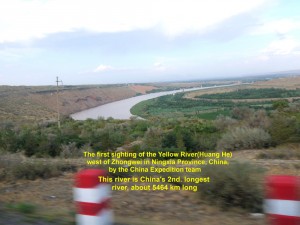
The first sighting of the Yellow River(Huang He) in Nimgxia Province, China by the China Expedition team
At 6.30 p.m. we, finally, reached Zhongwei City. We checked in at a hotel, Da Kong Hotel, first before we went to a restaurant nearby for dinner.
Journal of My 2013 China Expedition:
Written by Choo Chaw, Kluang, Johor, Malaysia

